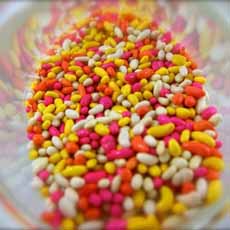TIP OF THE DAY: Make Sugar Plums
|
“Visions of sugar-plums danced in their heads.”
So goes a line from the immortal poem, “A Visit from St. Nicholas,” more commonly known as “The Night Before Christmas.”* Yet how many of us have recited or sung that line without knowing exactly what a sugar plum was? No matter what today’s confectioners sell as sugar plums—purple, plum-flavored, gumdrops and gummy candies are among them—here’s the real story. Let’s start with the fact that sugar plums are not plums coated in sugar. And that they are descended from comfits: seeds and other small centers that were sugar-coated through the technique known as sugar panning. In fact, the predecessors of sugar plums contained no fruit, but were instead hardened sugar balls with a seed, nut, or spice inside. They began as medieval comfits (the French word is dragées, drah-ZHAY), confectionery consisting of dried fruits, nuts, seeds or spices coated with layers. They are known as pastilles in the U.S. (or sometimes, they’re called pastels, an erroneous reference to the colored sugar). The confections were (and are) made by coating a small seed—anise, caraway, coriander, fennel—or diced ginger—with melted sugar (photo #1). Licorice pastilles (photo #2) were also popular—the forerunners of Good & Plenty. Almond comfits, also known as sugar almonds or Jordan almonds†, became popular favors for guests at baptisms and weddings. In the Middle Ages, all of these candies were coated in plain white sugar. The rainbow of colors came later. Small aniseed (and other) comfits evolved into larger aniseed balls, also sugar-coated. They were later joined by balls of spiced dried fruits and nuts fruits…which became known as sugar plums (photos #3 and #4). The term sugar plum came into general usage in the 1600s. “Plum” referred to the small size and spherical or oval shape of the confection. Before technology mechanized the process, the seeds and other centers were coated in a pan by adding layer by layer of melted sugar to build up the hard shell. It was a slow and labor-intensive process, and often took several days. Thus, these little candies were “luxury products.” It took a significant effort to make at home, and they were not inexpensive to purchase from the confectioner. (In fact, in the 18th century, the word “plum” became British slang for a large pile of money or a bribe [source].) By the 1860s, the Industrial Revolution engendered manufacturing with steam heat and mechanized rotating pans, comfits were now affordable for mass consumption. It’s not no more difficult to make sugar plums than to make cookies from scratch. Here are two recipes for starters. There are many more online. And if your sugar plums are for adults only, consider adding a splash of liqueur or brandy. |
 [1] Candy-coated fennel seeds have been a popular comfit since the Middle Ages. Many Indian restaurants have bowls of them, serving as an after-dinner breath freshener (photo courtesy Collective Pearls | WordPress).
[4] This sugar plums recipe has figs, pistachios and cocoa powder. Here’s the recipe from Katie At The Kitchen Door. |
|
|
________________ *Also called ‘Twas the Night Before Christmas” from its first line, the poem was first published anonymously in 1823 and much later attributed to Clement Clarke Moore, who claimed authorship in 1837. Modern scholars now attribute the poem to Henry Livingston, Jr., a Poughkeepsie army major and landholder (1748–1828). †English speakers call these sugar-coated almonds Jordan almonds, but they come from Spain. The word is a corruption of the French word for garden, jardin (zhar-DAN), which refers to the particular large variety of almond. |
||


